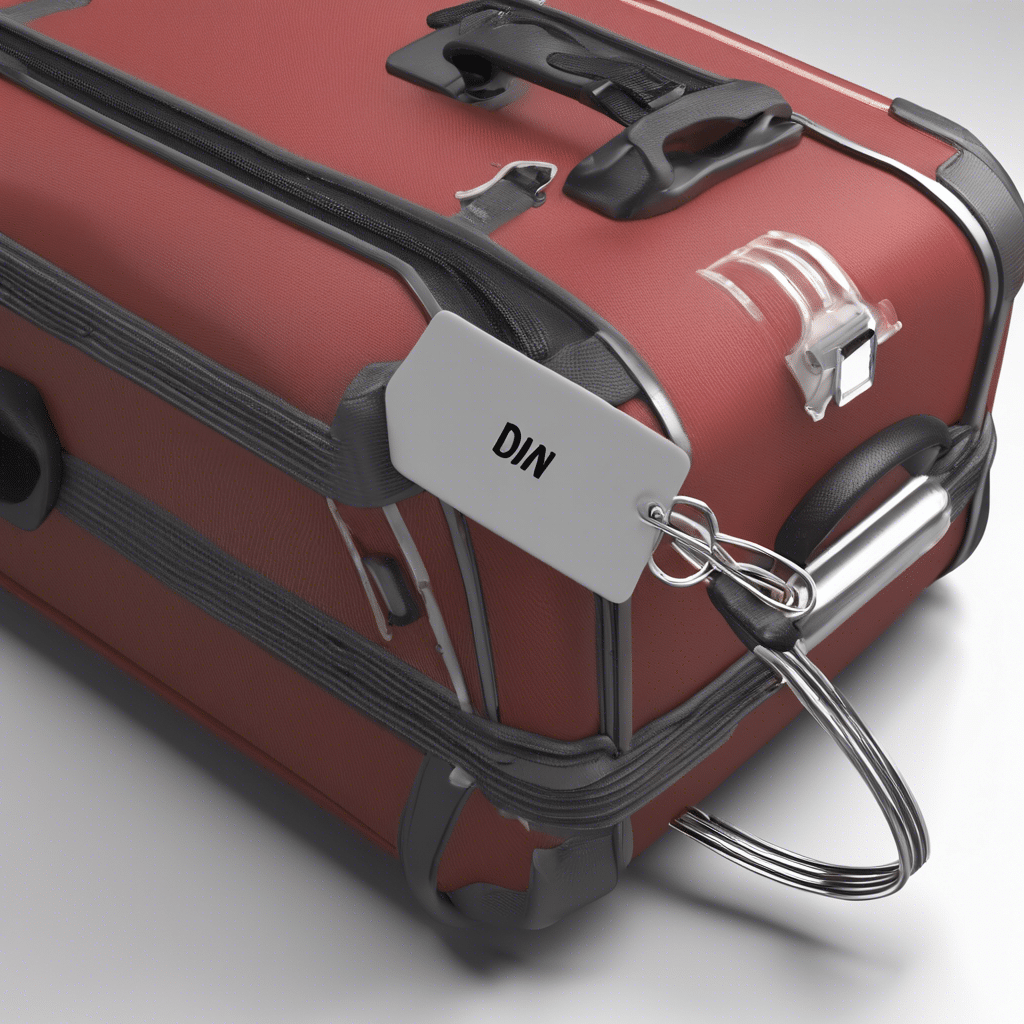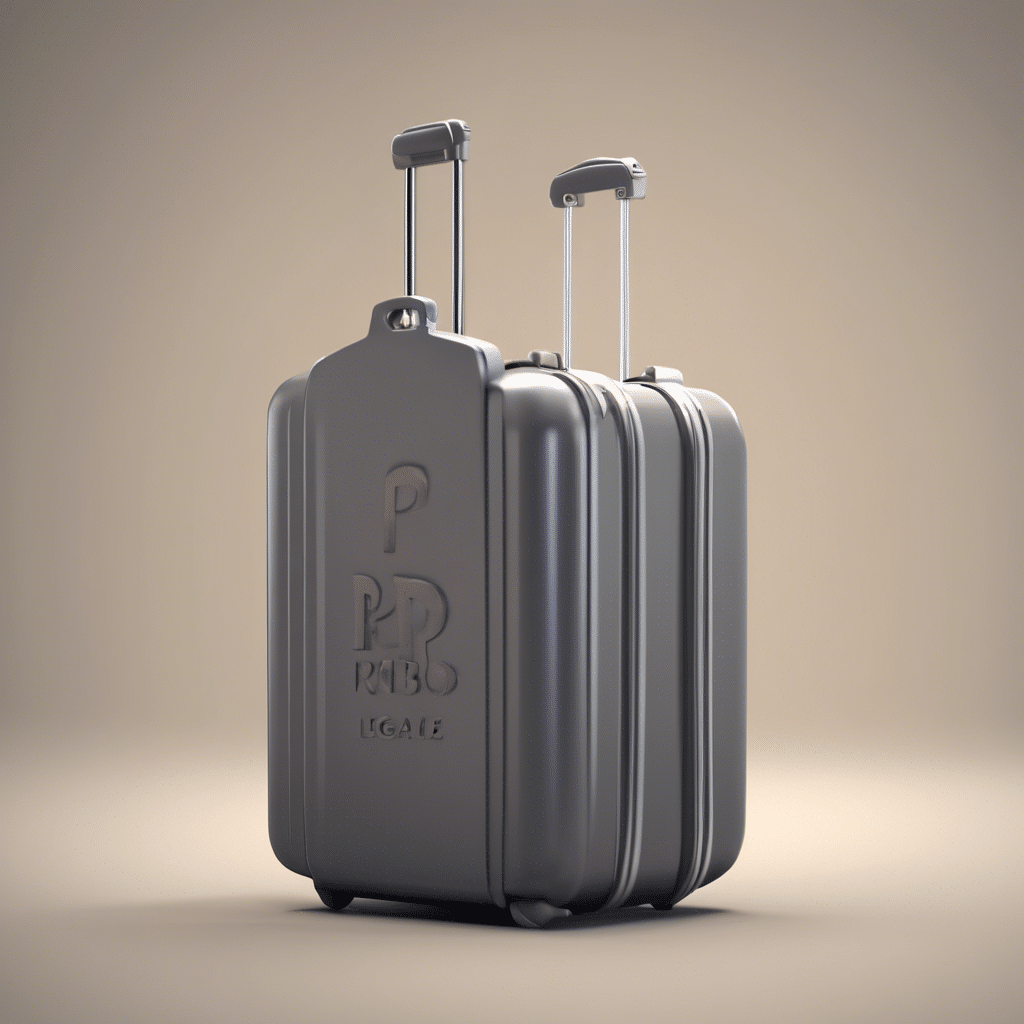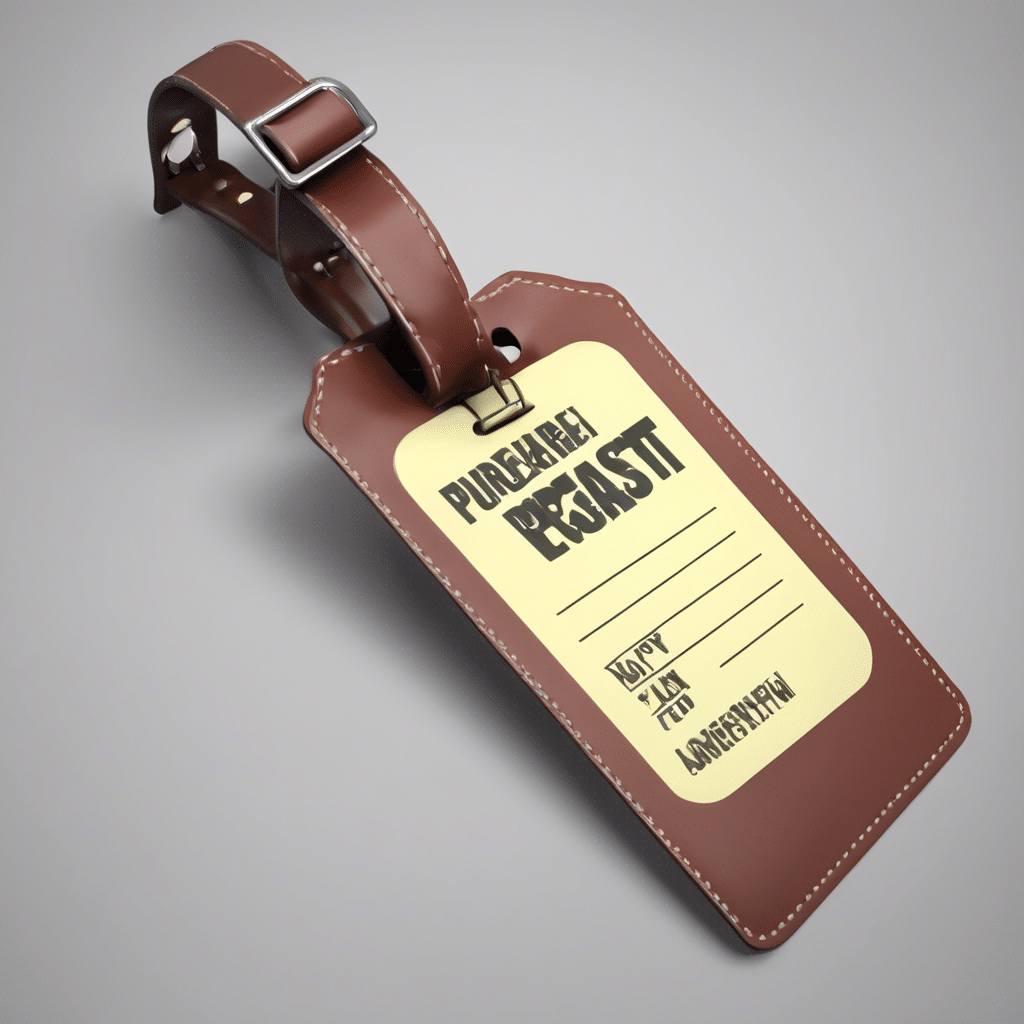“What To Put On Luggage Tag”: Luggage tags may seem like a small and insignificant part of travel, but they play a vital role in ensuring the safety and security of your belongings.
They serve as your luggage’s identification, making it easier to locate in case it gets lost or mistakenly taken by someone else. Additionally, luggage tags provide a professional and sophisticated touch to your belongings, especially when traveling for business purposes.

“What To Put On Luggage Tag”: When choosing what to put on your luggage tag, it is important to consider the essential information that can help identify your bag and facilitate its safe return to you. While it can be tempting to include personal details such as your home address or phone number, it is advisable to prioritize security and privacy in the digital age. Instead, opt for the following key information on your luggage tag:
1. Your Full Name: Ensure that your name is prominently displayed on the luggage tag. This way, it becomes easier for anyone who finds your lost bag to locate you or your contact information.
2. Mobile Phone Number: Include a reliable contact number, preferably your mobile phone number, where you can be reached at all times during your trip. This will allow the airline or the person who found your luggage to quickly get in touch with you.
3. Email Address: Including your email address on the luggage tag provides an additional way for someone to contact you in case your bag goes missing. Ensure that the email address you provide is one you frequently check.
4. Business Card: If you are traveling for business, attaching a business card to your luggage tag can add a professional touch while also providing an alternative means of identification. This allows airport staff or fellow travelers to reach out to you easily.
Remember to choose a sturdy and durable luggage tag that won’t easily break or get detached during your travels. Additionally, try to opt for a distinct and unique tag that stands out, making it easier for you to spot your luggage on the conveyor belt or in a sea of bags at the airport.
By ensuring that your luggage tag contains the necessary information and adheres to professional standards, you are not only safeguarding your belongings but also reinforcing your brand image when traveling for business. So, take a few moments to carefully consider what to put on your luggage tag, as it can make a significant difference in the event of lost luggage.
Importance of Having Luggage Tags

“What To Put On Luggage Tag”: Having a luggage tag may seem like a small detail when it comes to travel preparations, but it holds significant importance for every traveler. Whether you are traveling for business or pleasure, having a properly filled-out luggage tag can save you from potential stress and inconvenience. Here are a few reasons why luggage tags are essential for any traveler.
1. Easy Identification: At airports, train stations, or other transportation hubs, luggage tags offer a quick and easy way to identify your bag among the sea of similar suitcases. With so many bags looking alike, a luggage tag with your name, phone number, and address significantly increases the chances of getting your lost or misplaced bag returned to you promptly.
2. Prevents Bag Mix-ups: Imagine arriving at your destination only to find that someone else has mistakenly taken your bag because it looked identical to theirs. By having a luggage tag with unique and identifiable information, such as your contact details or a distinctive feature, you can avoid this type of mix-up and ensure that you leave with the right bag.
3. Time-Saver: In case your bag gets lost or delayed during your journey, luggage tags with your contact information can streamline the process of locating your bag. Airlines and transportation authorities can easily reach out to you and provide updates, making it easier for your bag to be returned as quickly as possible.
4. Professional Appearance: For business travelers, having a luggage tag adds a touch of professionalism to your overall presentation. It shows that you pay attention to details and are well-prepared for your travels. Additionally, a luggage tag with your company logo or branding can act as a subtle marketing tool, creating brand awareness wherever you go.
5. Security and Privacy: While it is important to have your contact information on your luggage tag, it is recommended to avoid displaying your full address or personal details. Instead, use a business address or simply include your name and a phone number. This ensures your privacy while providing enough information for someone to contact you if needed.
In conclusion, luggage tags are a small investment that provides numerous benefits for any traveler. They offer easy identification, prevent bag mix-ups, save time, enhance your professional appearance, and ensure the security of your belongings. Remember to take a few minutes to fill out a luggage tag before your next trip, and enjoy the peace of mind that comes with this simple but important travel accessory.
Purpose of the Blog Post

“What To Put On Luggage Tag”: When it comes to traveling, one important aspect that often gets overlooked is ensuring that your luggage has proper identification. The purpose of this blog post is to guide you on what information to include on your luggage tags.
By having a clear understanding of what to put on luggage tags, you can enhance the security and ease of travel for your belongings. Whether you are a frequent flyer or an occasional traveler, taking the time to properly label your luggage can help minimize the chances of your bags getting lost, provide contact information in case of emergencies, and make it easier for the airline staff to reunite you with your belongings.
In the following sections, we will discuss the essential details that should be included on your luggage tags, helping you ensure your baggage is easily identifiable, professional-looking, and ready for any unforeseen circumstances. So, let’s dive in and explore the various aspects of luggage tag etiquettes to help you travel confidently and hassle-free.
What to Put on Luggage Tags

“What To Put On Luggage Tag”: When it comes to traveling, one crucial item that often gets overlooked is the humble luggage tag. Although small in size, luggage tags play a vital role in ensuring that your bags make it safely to your destination. They not only help identify your luggage but also provide essential information for lost or misplaced bags to be returned to their rightful owners. To make the most of this tiny yet significant accessory, here are a few key pieces of information to include on your luggage tag:
1. Full Name: Make sure to prominently display your full name on the luggage tag. Including your first name, middle initial, and last name can help differentiate your bag from others with similar initials or surnames.
2. Contact Information: Provide a reliable contact number where you can be reached while you’re traveling. It’s best to include a cell phone number since it allows for easy communication regardless of your location.
3. Email Address: Along with your phone number, consider adding an email address to your luggage tag. This can serve as an alternative contact method and can be handy in case someone finds your bag outside regular hours or is unable to reach you by phone.
4. Home Address: Including your home address is optional but can be useful in the event that your luggage needs to be returned to your residence. If you are concerned about privacy, consider using a work address instead.
5. Travel Itinerary: While not crucial, including a brief overview of your travel plans can be helpful, especially if you have multiple destinations or connecting flights. This can assist airport personnel in rerouting your bag if it gets lost or misplaced during transit.
6. Remove Old Tags: Before attaching a new luggage tag, make sure to remove any old tags from previous trips. This prevents confusion and ensures that your current contact information is easily visible.
7. Additional Identification: Consider adding another form of identification to your luggage tag, such as a business card or an ID tag. This can assist in verifying ownership and speed up the process of reuniting you with your bag.
Remember to use a luggage tag that is durable and securely attach it to your suitcase or bag. Opt for a tag that has a cover or flap to protect your personal information from prying eyes. By including the right information on “What To Put On Luggage Tag”, you enhance the chances of a swift and seamless reunion with your belongings in case they accidentally go astray during your travels.
Full Name

“What To Put On Luggage Tag”: When it comes to filling out the information on your luggage tag, providing your full name is an essential element. Including your full name ensures that your luggage can be easily identified and returned to you in case it gets lost or misplaced during your travels.
It is important to write your full name clearly and legibly on the luggage tag to avoid any confusion. Remember to use your complete legal name as it appears on your identification documents. Having your full name prominently displayed on the luggage tag not only adds a professional touch but also helps airline staff and baggage handlers to quickly locate your belongings and reunite you with your luggage as efficiently as possible.
Including First and Last Names for Identification Purposes

“What To Put On Luggage Tag”: Including first and last names on a luggage tag is essential for identification purposes. When traveling, it is important to ensure that your luggage is easily identifiable and distinguishable from others, especially in busy airports or crowded baggage claim areas. By including your first and last name on the luggage tag, you provide a clear and concise way for someone to contact you if your luggage gets misplaced or lost during your journey.
Including both your first and last name adds a level of professionalism and clarity to the identification process. It allows airport personnel or fellow travelers who may come across your misplaced luggage to immediately identify the owner. This can expedite the process of locating and retrieving your luggage, saving you time, stress, and potential inconvenience during your travels.
Moreover, including your first and last name also helps to prevent any confusion or mix-ups with luggage that may have similar or identical appearances. With so many travelers using similar suitcases or bags, having a distinct identification tag can make all the difference in quickly identifying and retrieving your belongings.
When determining “What To Put On Luggage Tag”, it is recommended to use clear and legible handwriting or opt for a printed label to ensure that it is easily readable. Using a font size that is large enough to be noticed at a glance is also advisable. Remember, the goal is to make it as effortless as possible for anyone who comes across your luggage to identify the owner and facilitate its return.
In summary, including your first and last name on a luggage tag is a simple yet effective way to enhance the identification process for your belongings. By doing so, you increase the likelihood of speedy recovery should your luggage go missing during your travels. So, be sure to make this a priority when preparing for your next trip.
Contact Information

“What To Put On Luggage Tag”: When it comes to filling out your luggage tag, one of the most crucial pieces of information to include is your contact information. If your luggage is misplaced or lost during your travels, having your contact details easily accessible can significantly increase the chances of reuniting with your belongings.
Here are a few key points to consider when it comes to including contact information on your luggage tag:
1. Name: Begin by clearly writing your full name on the luggage tag. Make sure to use your legal name, as this will make it easier for airport personnel or hotel staff to identify you.
2. Phone number: Provide a contact number where you can be reached during your trip. Consider including a cell phone number that is easily accessible and will likely be in service while you’re traveling. If you have an international roaming number or a local contact number at your destination, it is advisable to include those as well.
3. Email address: Including an email address where you can be reached is helpful, especially if you are unable to answer phone calls or if your phone is out of service. Providing an alternative way to contact you can facilitate communication between you and the person who found or has possession of your luggage.
4. Home address: While some travelers prefer not to include their home address on their luggage tags for security reasons, others find it useful in case the lost luggage needs to be shipped back to their primary residence. If you are comfortable with including your home address, consider writing it down on the luggage tag as well.
Remember to double-check the accuracy of the contact information you provide and to ensure that it is clearly written to avoid any confusion. Additionally, it is a good idea to put your contact information both on the outside and inside of your luggage, as tags can sometimes get torn or damaged during transportation.
By including your contact information on your luggage tag, you are taking proactive steps to ensure that your belongings can be returned to you in the event of loss or misplacement. It is a small yet essential detail that can help maintain peace of mind during your travels.
Phone Number and/or Email Address to Enable Communication in Case of Loss

“What To Put On Luggage Tag”: When it comes to traveling, one of the essential items you should never forget is a luggage tag. This small accessory plays a significant role in identifying your belongings and ensuring they make it back to you in case they get misplaced or lost. One crucial aspect of a luggage tag is including your contact information, such as your phone number and/or email address.
Including your phone number on the luggage tag provides an immediate and direct way for anyone who finds your lost luggage to get in touch with you. In case your luggage is misplaced during a layover or mistakenly taken by another traveler, having a visible phone number can help expedite the return process. When providing your phone number, make sure to include the appropriate country code if you are traveling internationally. This will ensure that anyone finding your bags can easily reach you, regardless of their location.
Additionally, including your email address on the luggage tag is another convenient way to facilitate communication. Sometimes, people may not be able to make a phone call immediately or prefer to send an email instead. By including your email, you give the finder of your luggage an alternative method to reach out and provide necessary details about the lost item.
However, it’s essential to be cautious about the amount of personal information you display on the luggage tag, especially concerning security and privacy. Avoid including your full name or home address to prevent potential risks. Instead, focus on providing the most crucial information – a phone number and/or email address will suffice.
Remember to choose a legible font and size for your contact information to ensure it can be easily read. Additionally, select a durable luggage tag that can withstand the rigors of travel, including exposure to different weather conditions and potential mishandling.
A sturdy tag with a clear plastic cover can protect your contact information from smudging or fading over time. This attention to detail in deciding “What To Put On Luggage Tag” can greatly enhance the effectiveness of your luggage identification system and contribute to a smoother travel experience.
By including your phone number and/or email address on the luggage tag, you greatly increase the chances of recovering your lost belongings. Providing clear and easily accessible communication options ensures that anyone who finds your luggage can promptly notify you and arrange for its safe return, helping you maintain peace of mind during your travels.
reflect any changes in your contact information, ensuring a seamless process in case your luggage gets misplaced.

By carefully considering the information you include on your luggage tag, you can strike a balance between prioritizing your safety and increasing the chances of your lost luggage being returned to you promptly and efficiently.
In conclusion, deciding “What To Put On Luggage Tag” is a critical consideration for any traveler. Luggage tags serve as the first line of defense in ensuring the safe return of your belongings in the event they are lost or misplaced during your journey. By including essential information such as your full name and contact details, you significantly increase the chances of your luggage being reunited with you promptly.
Additionally, prioritizing security and privacy in the digital age by refraining from including sensitive personal information is essential. With a properly filled-out luggage tag, you can travel with confidence, knowing that your belongings are properly identified and easily traceable.